Unit 1: Exploring the Nature of Light Phenomena
VIII. Using Additional Central Ideas about Light to Explain an Intriguing Phenomenon
We can use these additional central ideas about reflection, refraction, and dispersion to explain a beautiful phenomenon: a rainbow.
Question 1.24 How are rainbows formed?
- When you see a rainbow, where are you standing with respect to where the sun and rain are?
- Is the sun behind you, high above you, or in front of you?
- Is the rain behind you, raining straight down on you, or some distance away in front of you?
- Make a sketch that shows where you are with respect to the sun and rain.
- What happens when light from the sun enters a water drop?
- What happens when light rays move from one medium into another such as from air into water?
- Make a ray diagram showing white rays from the sun entering a water drop.
Show only one color as rays of that color move from air into the drop.
- What happens when light rays reflect off a smooth surface?
- Continue your ray diagram showing rays of one color reflecting off of the inner surface of the drop, back into the drop.
- What happens when light rays move from one medium into another, such as from water into air?
- Continue your ray diagram showing rays of one color leaving the water drop and traveling through the air.
- Will colors from the same drop reach the observer’s eye?
- Continue your ray diagram showing rays of one color traveling to the observer’s eye.
- Consider whether rays of another color would exit this drop in a direction toward the observer’s eye.
- Add another drop at a different height from which a different color reaches the observer’s eye.
- Summarize how light from the sun sometimes forms a rainbow in the sky.
Complete your ray diagram and summary before looking at an example of student work and nuances about explaining rainbows.
1. Example of student work explaining rainbows
A student began explaining rainbows with a sketch of where someone is who is seeing a rainbow, with respect to the sun and the rain, and a ray diagram showing how one can envision what happens when light rays enter water drops in just the right way to form a rainbow as shown in Fig. 1.44.
(Figure 1.44) is a sketch of someone seeing a rainbow. The Sun is behind the person and the cloud with raindrops is in front of the person.
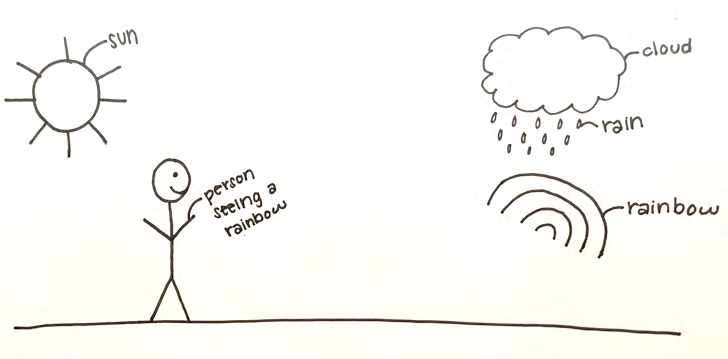
(Figure 1.45) is a ray diagram with the Sun, two rain drops, and a person’s eye.
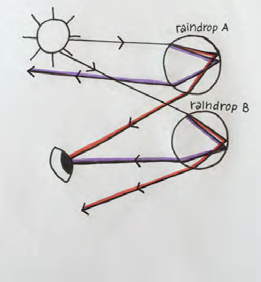
The ideas above can be used in tracing the two continuous rays in (Fig. 1.45), in order to explain how someone can see a rainbow.
First of all, white light disperses into its component colors when moving from one medium into another such as from air into a prism or water.
In Figure (1.45), the two light rays that are shown leaving the sun in the direction of the raindrops are white light. Once those white light rays hit the raindrops, which is a change in medium from air to water, it can be seen that the white light disperses into its component colors, which is represented by the red and violet rays seen inside of the raindrops. Next, light rays refract (bend, change direction) at the surface when light moves from one medium into another such as from air to water or from water to air. This refraction is first seen in Figure (1.45) in each of the raindrops directly when the light rays first hit the raindrops, since the rays are moving from the medium of air to the medium of water.
Next, light rays reflect from smooth surfaces in a regular way, where the angle of reflection equals the angle of incidence. This is seen in Figure (1.45) when both the red and the violet rays hit the back of the raindrops, which are smooth surfaces, and they reflect off in the same angles as which they came in, which are the angles of incidence.
Finally, refraction is seen again in Figure (1.45). The second time that refraction is seen is when the light rays are leaving the raindrops, since the rays are moving from the medium of water to the medium of air. When the light rays leave the raindrops, the red rays bend less than the violet rays. So, in the raindrop on the top, only the red light rays exit at the correct angle to travel to the observer’s eye. In the raindrop on the bottom, only the violet light rays exit at the correct angle to travel to the observer’s eye. Since we only see one color from each raindrop, that is how a rainbow is seen.
Physics student, Spring, 2016
2. Nuances in using central ideas about reflection, refraction, and dispersion to explain rainbows
A step by step view of the processes involved in forming rainbows can be helpful:
First the white light rays from the Sun are envisioned as being refracted on entering a water drop with different colors bending at different angles. Violet bends the most, red the least. The other colors bend in between. Figure 1.46 shows this first step of white light entering a raindrop and one of its component colors bending toward the normal at a particular angle at the surface of the drop.
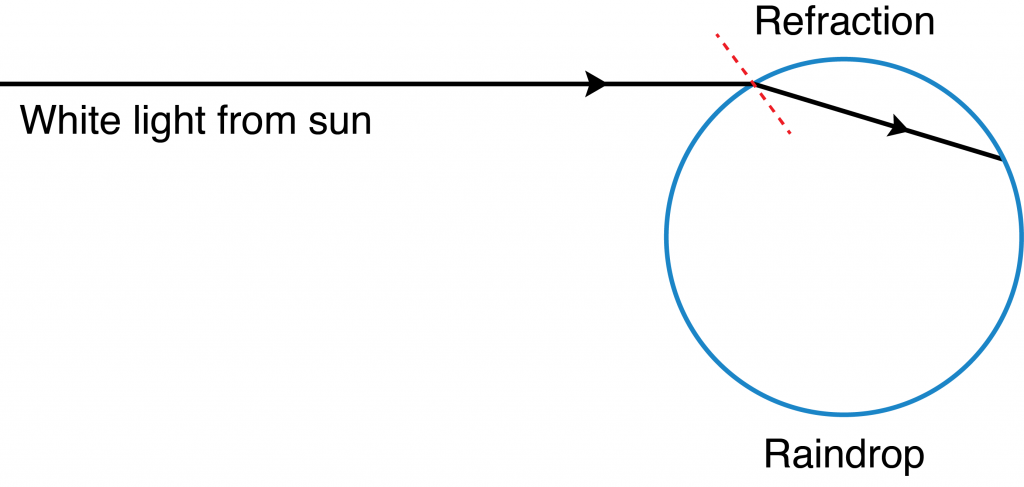
Next the colored light ray is envisioned as moving through the rain drop and encountering the inner surface of the other side of the raindrop. What happens there?
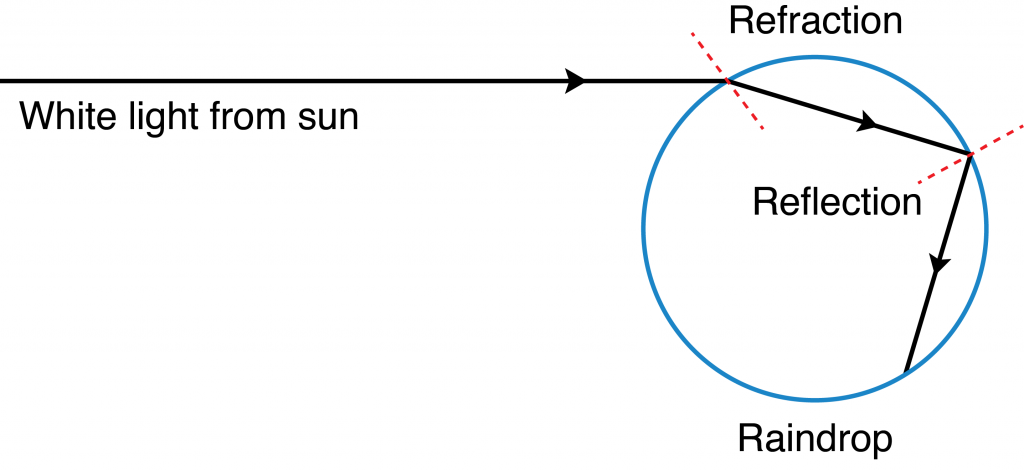
As shown in Fig. 1.47, when rays of a particular color enter a drop, they are envisioned as bending and continuing to move in a straight line in a direction away from the observer until they reach the smooth inner surface of the raindrop. As shown in Fig. 1.47, some are envisioned as being reflected internally at the inside surface, where angle of reflection equals the angle of incidence for each color. These rays are envisioned as now heading back in a direction toward the observer.
Then the rays of all colors are envisioned as moving back through the raindrop to the original side they entered, but now traveling in the opposite direction. What happens there?
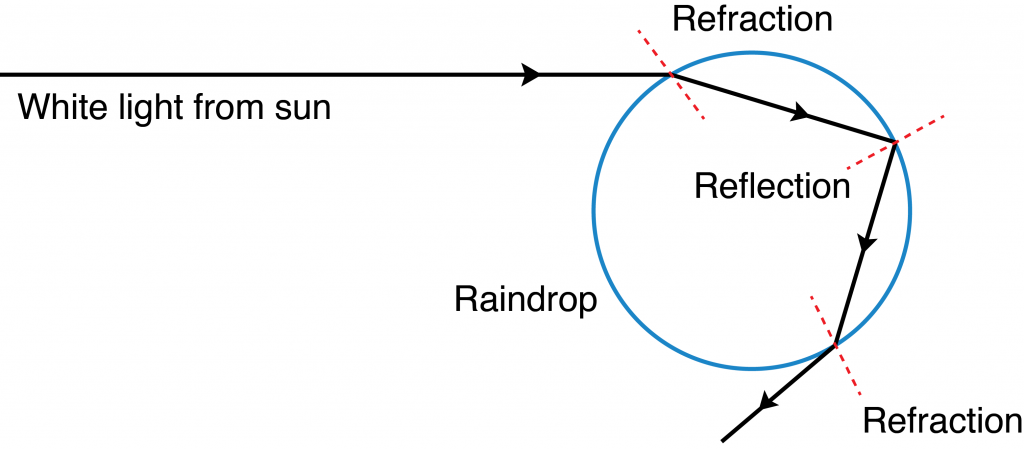
As shown in Figure 1.48, rays of this color are envisioned as being refracted again as they leave the raindrop in the direction of the observer, bending again, but away from the normal at a particular angle for that color. The red rays leave the surface below the green rays, which are below the blue rays. This is the inverse order to colors seen in a rainbow.
As shown in Fig. 1.48, the entire trip through a rain drop is envisioned as involving a) refraction as white light enters the raindrop and separates into its component colors as each color bends at its own angle, b) reflection of each color at the opposite inner surface with color’s angle of reflection equal to its angle of incidence, and then c) refraction again but in a direction toward the observer as the rays of each color leave the raindrop.
Note that if you see a rainbow you are seeing light from DIFFERENT raindrops. The red light is coming from drops high in the sky, the violet light from drops lower in the sky (See: http://science.howstuffworks.com/nature/climate-weather/atmospheric/question41.htm).
Figure 1.49 shows a ray diagram drawn by Rebecca McDowell when she was a second year Bachelor of Teaching student at the University of Melbourne, Victoria, Australia. She included many colors of the spectrum and represented someone seeing different colors from raindrops at different heights.
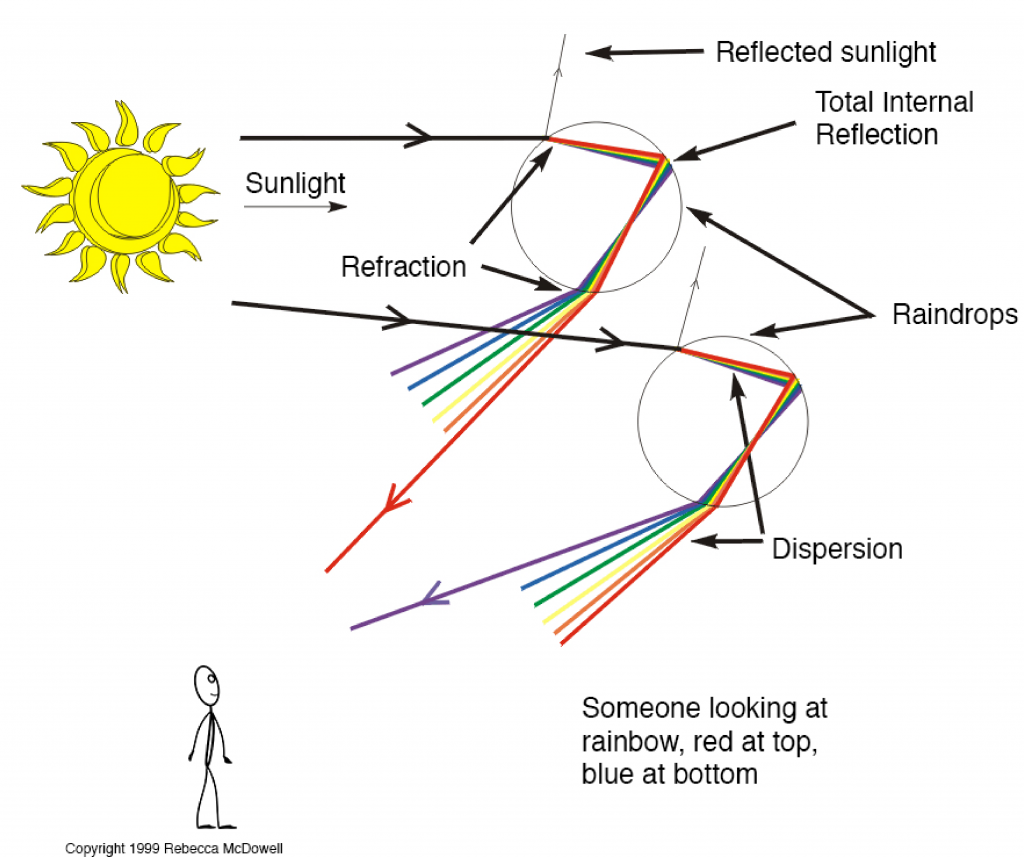
Next time you see a rainbow, enjoy!
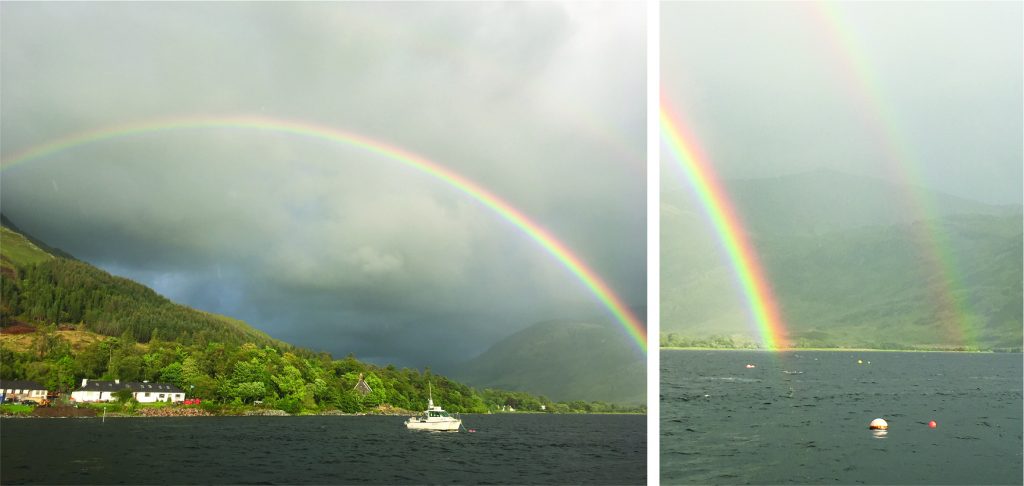
Images by Katrina van Zee from a sailboat in Loch Nevis, Scotland.
As shown on the right in Fig. 1.50, the order of the colors in the faint secondary bow of a double rainbow is reversed with red light forming the inner arc. The explanation involves a similar model of envisioning light rays from the Sun refracting, reflecting, and refracting as they enter and leave raindrops. In a secondary bow of a double rainbow, however, the incoming refracted light rays are envisioned as reflecting twice within a raindrop rather than once, with violet light coming from higher drops and red light from lower ones. (See https://www.metoffice.gov.uk/weather/learn-about/weather/optical-effects/rainbows/double-rainbows and http://hyperphysics.phy-astr.gsu.edu/hbase/atmos/rbowpri.html#c2.)
The process of using models to develop explanations of complex phenomena is an example of an aspect of the nature of science articulated in the US Next Generation Science Standards that science models, laws, mechanisms, and theories explain natural phenomena (NGSS, Lead States, 2013, Appendix H) (See: https://www.nextgenscience.org/resources/ngss-appendices.)

